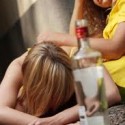Drinking ourselves to death
We’ve all heard the sermons and lectures. It is generally agreed that drinking alcohol – in excess – can be self-damaging. However very few of us know, or even pause to consider – how much is too much?
For most of us, the post-party hangovers, scrapes and empty wallets are the only gauge of our previous night’s drinking. These are usually the most effective incentives to cut back at the next party. Sadly, it is difficult to grasp the idea that our current drinking habits may have long-reaching consequences.
When we drink in Ireland, it is often to the point of drunkenness. In fact, according to a 2007 study we have the highest binge-drinking rate in Europe at 34 per cent of drinkers over-indulging in alcohol. The next closest? Finland, at 27 per cent.
Binge drinking is most simply defined as drinking to get drunk. The World Health Organisation (WHO) describes it as five or more units of alcohol in one drinking session. This translates to 2.5 pints of beer, 5 shots, or 5 small glasses of wine. This may not seem like a lot, does it? But therein lies the problem.
It was estimated by the WHO in 2001 that a quarter of deaths among men aged 15-29 in Europe were, at that time, attributable to alcohol. A 2003 report indicates that 33 per cent of Irish males and 22 per cent of females drink over the recommended weekly intake of alcohol – 21 and 14 units respectively.
In 2003, it was estimated that the total spending and lost revenue from alcohol related episodes was over €2.6 billion in Ireland. And teenage and underage drinking is still rising.
Indeed, these figures are worrying, but they are still somewhat remote. It is difficult to relate to cold statistics. But if we look around us, it is not difficult to find a family problem, crime or someone hurt by alcohol. Between 1995 and 2004, 1,775 people died as a result of alcohol abuse in Ireland alone.
In fact, 88 per cent of public offences are related to alcohol, 34 per cent of divorces cite alcohol as the main cause of breakdown, and 38 per cent of road deaths are alcohol related. One in every eight patients attending accident and emergency rooms is a result of an alcohol related injury.
In addition to the socially destructive nature of alcohol consumption, it is important to explore the impact it has on our health. When we start consuming alcohol, generally the liver can metabolise one standard unit per 90 minutes. When we drink more than one per hour, alcohol builds in our blood, starts affecting the brain, and we feel drunk.
Alcohol depresses activity in the brain, therefore leading to slower reflexes, impaired judgement, and highly emotional states. It makes your emotions more potent, which means it enhances the current mood we are in – if we are sad, we usually become sadder.
In moderation these effects are pleasurable, however extremely heavy drinking can shut the brain down completely, causing blackouts, killing cells and causing minor brain damage. And this happens more often than we realise.
As we drink, alcohol causes us to urinate far more frequently than normal. As a result we become extremely dehydrated. Organs steal water out of the blood stream to stay alive, and consequently our brain shrinks – a big part of the hangover headache.
And high amounts of alcohol cause damage to our liver and other vital organs. After a heavy bout of drinking, the liver releases the same enzymes as it would if it were physically assaulted. The toxic effects of alcohol coupled with dehydration and other insults, acutely damages other organs as well.
Chronic binging causes repeated damage to these organs, which can lead to cirrhosis of the liver, irreversible damage to the heart, blood vessels and kidneys. It also raises the chances of other diseases such as heart disease.
These problems are exacerbated for women, since they metabolise and tolerate alcohol less efficiently than males. On average, two units of alcohol will have the same effect on women as three units on men.
This is simply because women are physiologically different – and also face a different set of challenges. For instance, alcohol is a major factor in the participation of unprotected sex, leading to unplanned teen pregnancies. These risks are significantly higher in the 18-25 age range. And unprotected sex also leads to higher rates of sexually transmitted infections amongst both sexes.
The alcohol-related behaviour we experience, perhaps even embrace, in Irish society may be normal to us, but to the majority of the world it is an undesirable model. We can only change the current state of affairs by first becoming knowledgeable about them.
source: University Observer
